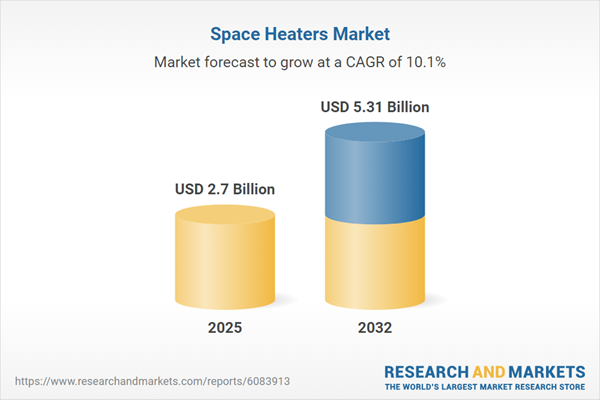Speak directly to the analyst to clarify any post sales queries you may have.
Senior executives evaluating industry transformation can look to the space heaters market as a prime example of rapid evolution, shaped by integration of emerging technology, regulatory change, and the growing expectations of diverse end users.
Market Snapshot: Space Heaters Market Growth at a Glance
The space heaters market expanded from USD 2.46 billion in 2024 to USD 2.70 billion in 2025 and is forecast to reach USD 5.31 billion by 2032, reflecting a CAGR of 10.09%. This sustained growth highlights strong global demand for advanced indoor climate solutions, with priorities shifting toward higher energy efficiency, flexible operating functions, and adoption of digitally enabled systems. Regulatory measures around energy usage and expectations for smart features are fueling innovation in both commercial and residential sectors. Market development reflects the interplay of end-user preferences and industry responses to efficiency mandates and rapid advancements in product technology.
Scope & Segmentation: In-Depth Coverage of the Space Heaters Market
This comprehensive market research report provides full coverage of the global space heaters market, segmented to support strategic planning and investment. The analysis presents core market divisions and key technological trends shaping the sector:
- Product Types: Ceramic, Convection, Fan, Oil-Filled, and Radiant heaters, allowing choice for diverse heating needs in varying climates.
- Power Sources: Electric, Gas, and Propane, reflecting demand for versatility in energy supply and use cases.
- Applications: Indoor and Outdoor, supporting deployment in varying environments and operational requirements.
- End Uses: Commercial, Industrial, and Residential segments, each with unique compliance, performance, and design needs.
- Distribution Channels: Offline channels such as hypermarkets, independent stores, and specialty shops, as well as online channels including manufacturer websites and third-party platforms.
- Regions Covered: Americas (North America, Latin America), Europe, Middle East & Africa, and Asia-Pacific, capturing global market trends and regional disparities.
- Companies Profiled: Major players such as De'Longhi Appliances S.r.l., Honeywell International Inc., Newell Brands Inc., Glen Dimplex Group, Lasko Products LLC, Midea Group Co. Ltd., Dyson Ltd, Vornado Air LLC, Electrolux AB, and Mitsubishi Electric Corporation.
Technology adoption underpins growth, with integration of IoT, user-friendly digital control systems, and ongoing innovations in ceramic and radiant heating. The sector is also responding to raw material volatility and logistical pressures by modernizing supply chains, including strategic moves toward nearshoring and supply chain digitalization. These themes align with the rising emphasis on performance, sustainability, and market adaptability.
Key Takeaways for Decision-Makers
- Adoption of smart connectivity is becoming a defining factor, enhancing user engagement and allowing remote operation and proactive maintenance scheduling.
- Investment in advanced thermal materials is facilitating faster, more efficient heating, answering consumer demands for environmental responsibility and ease of use.
- Sustainability is now central to innovation and product portfolio planning, with hybrid solutions and emissions compliance emerging as competitive factors.
- Manufacturers are building in greater resilience to supply-chain shocks by pursuing local partnerships and nearshoring to reduce exposure to regulatory and logistical disruptions.
- Collaboration between equipment makers, grid operators, and technology providers is enabling the rollout of value-added services such as maintenance subscriptions and demand management.
- Regional demand signals vary: North American and European buyers value efficiency and integrated digital features, while price and adaptability remain high priorities in certain Asia-Pacific and African markets.
Tariff Impact on Supply Chains
Recent US tariffs and global trade changes have prompted manufacturers to rethink sourcing strategies and production locations. In response, the industry is increasing investment in domestic assembly, building partnerships with regional suppliers, and implementing digital supply chain solutions. This shift is leading market participants to adopt more agile procurement and inventory management practices, positioning them to navigate ongoing economic and regulatory transitions more effectively.
Methodology & Data Sources
Research for this report combined comprehensive secondary analysis of industry publications, technical standards, and regulatory filings with primary interviews and surveys involving executives and technical experts across target markets. Findings were validated through triangulation, extrapolation, and expert peer review to ensure accuracy and actionable insights.
Why This Report Matters: Actionable Insights for Leadership
- Pinpoint innovation-driven growth opportunities and manage risk stemming from shifting supply chain structures and regulatory policies.
- Leverage segmentation-focused intelligence to inform product strategy and guide decisions around investment in emerging technologies.
- Benchmark against industry peers, monitor evolving regional demands, and align with best practices and compliance standards to maintain competitiveness.
Conclusion
The space heaters market demonstrates a pivot toward intelligent, sustainable, and adaptable operations. Leadership teams leveraging these insights can refine strategy, foster stronger collaborations, and respond effectively to evolving regulatory and market conditions.
Table of Contents
3. Executive Summary
4. Market Overview
7. Cumulative Impact of Artificial Intelligence 2025
Companies Mentioned
The companies profiled in this Space Heaters market report include:- De'Longhi Appliances S.r.l.
- Honeywell International Inc.
- Newell Brands Inc.
- Glen Dimplex Group
- Lasko Products, LLC
- Midea Group Co., Ltd.
- Dyson Ltd
- Vornado Air, LLC
- Electrolux AB
- Mitsubishi Electric Corporation
Table Information
| Report Attribute | Details |
|---|---|
| No. of Pages | 196 |
| Published | November 2025 |
| Forecast Period | 2025 - 2032 |
| Estimated Market Value ( USD | $ 2.7 Billion |
| Forecasted Market Value ( USD | $ 5.31 Billion |
| Compound Annual Growth Rate | 10.0% |
| Regions Covered | Global |
| No. of Companies Mentioned | 11 |









